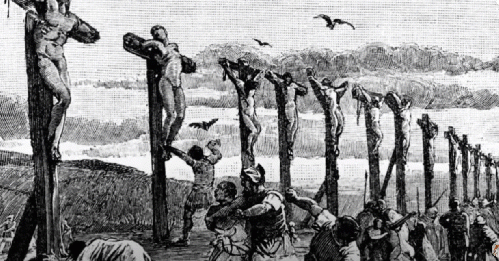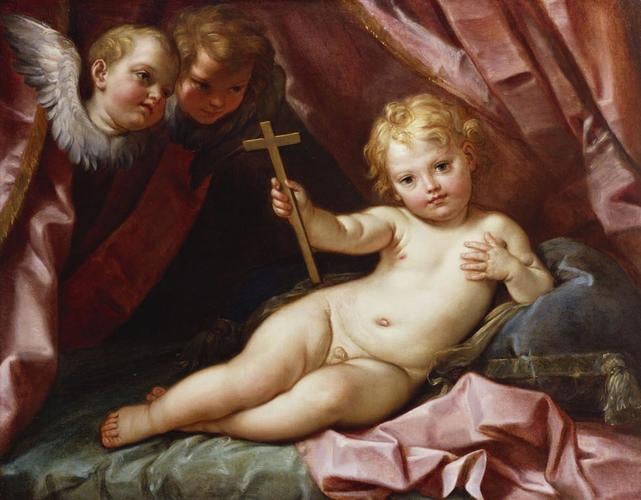Imagine a painting of a Bar Mitzvah service. The rabbi beams as he stands next to a 13-year who is reading a passage in the Torah scroll. He points to the passage as the young man reads aloud. In his other hand, the rabbi displays a crucifix. A crucifix is a cross with the image of Jesus on it. Wouldn't the appearance of that cross demand an explanation?
What would an art critic or historian say about this painting? Surprisingly, in our imagined scenario, the critics and the historians praise the lighting and perspective, the richness of the colors, and the rendering of extraordinary details, but they don't mention the cross. They don't ask the most obvious question: "What the hell is the rabbi doing displaying a cross?" Has the orthodox Rabbi embraced Jesus? Is it possibly an expression of reconciliation with Christianity? Or is it something else? The absence of an explanation, commentary, or even mention of the cross, the symbol of historical persecution and violence against Jews, would be shocking and likely to generate a tsunami of outrage.
A far-fetched scenario, you say. But a similar scenario has occurred in the past. Not once, but repeatedly for centuries. And remarkably it has survived unnoticed.
Jesus, a Jewish preacher, was called Rabbi by his followers. He lived and died a dedicated Jew, as confirmed by a consensus of Christian and Jewish scholars.. Yet in countless numbers of artworks, most prolifically in the Renaissance period, Jesus, his mother Mary, and his disciples--all dedicated practicing Jews--are pictured holding or wearing a cross, often in totally Christianized settings with Church officials and Christian Saints. Often the infant Jesus is pictured holding a cross defining him as a Christian at birth--a glaring falsification of biblical history
Make no mistake about it, in the time of Jesus the cross was a feared symbol of terror, torture, and mass killings. Crucifixion was a brutal and barbaric form of execution designed for maximum pain and suffering. It was feared by both Jews and non-Jews. Throughout the reign of the Roman Empire, crucifixion and its symbol, the cross, evoked terror. And Jesus was not the first or only Jew to be crucified. In one incident alone in 7 CE 2000 Jews were crucified after a minor revolt in Judea. Crucifixion was so horrific that Roman philosopher Cicero refused to mention it in his writings. He said: "The word 'cross' should never be mentioned in polite society. "Let the very word 'cross,' be far removed from not only the bodies of Roman citizens, but even from their thoughts, their eyes, and their ears."
It is no surprise that the cross would not become a devotional Christian symbol for another three hundred years after the crucifixion of Jesus. As I imagined outrage at the painting of the rabbi holding a crucifix, if Jews in the time of Jesus had seen artworks of Jews displaying a cross it would have similarly evoked a tsunami of outrage
These artworks of identity theft, which falsely converted devout Jews to non-existent Christianity, not only fabricated biblical history but also fed the illusion that Jesus and his followers became Christians. In fact, Christianity did not exist in Jesus' lifetime in concept or word. The four Gospels, which chronicle the three-year spiritual mission of Jesus, do not contain the word "Christian." However, the word "Jew" appears 82 times and the word "rabbi," in reference to Jesus, is expressed many times as well.
How is it possible that for centuries this shameful falsification certainly as puzzling and objectionable as the rabbi displaying a crucifix has had a free ride under the radar?
Art professionals have exhibited a monumental failure of scholarship about Judaism and Christianity in the time of Jesus by not recognizing or calling out the fabrication of these artworks. And that lapse of scholarship persists today. Go to any exhibit of Renaissance art and witness the commentaries about these images of Jesus, his mother Mary, and his Jewish apostles and followers displaying the cross, a symbol of terror and brutality with no recognition or commentary. More egregious, these art "experts" did not understand that they were participating in and promoting antisemitism. They did not realize that they contributed to the weaponization of the Christ Killers' charge by falsely establishing that the Jews didn't just kill Jesus, they killed the Christian Jesus--a charge that incited persecution and violence against Jews.
Over centuries, that charge has gained tenacious traction. Although in 1965 the Second Vatican Council disavowed collective Jewish guilt for the death of Jesus and Pope Benedict XVI in his 2011 book Jesus of Nazareth Part Two declared that the Jewish people were not responsible for the death of Jesus, the concept of Jews as Christ Killers persists in 21st-century America. According to the most recent poll, as many as 26 percent of Americans still believe that the Jews were responsible for the death of "Christ." The numbers may be even higher since people are reluctant to tell the truth on sensitive issues. Sadly, the persistent belief in the Christ Killers charge may be an underpinning factor in the current rise in antisemitism.
Isn't it time for the truth to be told? Setting the historical record straight would not diminish the appreciation of the artworks' magnificence or the talent of the artists. Instead, correcting these historical errors would reveal a great deal about antisemitism, which was deeply embedded in Christian Europe through a large span of history.
(Note: You can view every article as one long page if you sign up as an Advocate Member, or higher).







